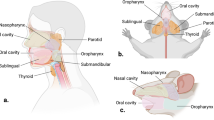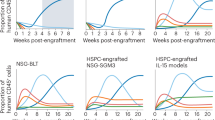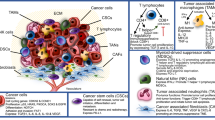Abstract
Head and neck cancers (HNCs) cause significant mortality and morbidity. There have been few advances in therapeutic management of HNC in the past 4 to 5 decades, which support the need for studies focusing on HNC biology. In recent years, increased recognition of the relevance of the host response in cancer progression has led to novel therapeutic strategies and putative biomarkers of tumor aggressiveness. However, tumor-immune interactions are highly complex and vary with cancer type. Pre-clinical, in vivo models represent an important and necessary step in understanding biological processes involved in development, progression and treatment of HNC. Rodents (mice, rats, hamsters) are the most frequently used animal models in HNC research. The relevance and utility of information generated by studies in murine models is unquestionable, but it is also limited in application to tumor-immune interactions. In this review, we present information regarding the immune-specific characteristics of the murine models most commonly used in HNC research, including immunocompromised and immunocompetent animals. The particular characteristics of xenograft, chemically induced, syngeneic, transgenic, and humanized models are discussed in order to provide context and insight for researchers interested in the in vivo study of tumor-immune interactions in HNC.
This is a preview of subscription content, access via your institution
Access options
Subscribe to this journal
Receive 50 print issues and online access
$259.00 per year
only $5.18 per issue
Buy this article
- Purchase on Springer Link
- Instant access to full article PDF
Prices may be subject to local taxes which are calculated during checkout

Similar content being viewed by others
References
Ferlay J, Soerjomataram I, Dikshit R, Eser S, Mathers C, Rebelo M, et al. Cancer incidence and mortality worldwide: sources, methods and major patterns in GLOBOCAN 2012. Int J Cancer. 2015;136:E359–386.
Siegel RL, Miller KD, Jemal A. Cancer statistics, 2016. CA Cancer J Clin. 2016;66:7–30.
Jacobson MC. The experience of head and neck cancer survivorship (including laryngectomy): an integrated biopsychosocial model. Curr Opin Support Palliat care. 2018;12:65–73.
Lea J, Bachar G, Sawka AM, Lakra DC, Gilbert RW, Irish JC, et al. Metastases to level IIb in squamous cell carcinoma of the oral cavity: a systematic review and meta-analysis. Head Neck. 2010;32:184–90.
Fan S, Tang QL, Lin YJ, Chen WL, Li JS, Huang ZQ, et al. A review of clinical and histological parameters associated with contralateral neck metastases in oral squamous cell carcinoma. Int J Oral Sci. 2011;3:180–91.
Noguti J, De Moura CF, De Jesus GP, Da Silva VH, Hossaka TA, Oshima CT, et al. Metastasis from oral cancer: an overview. Cancer Genom Proteom. 2012;9:329–35.
Ho AS, Kim S, Tighiouart M, Gudino C, Mita A, Scher KS, et al. Metastatic Lymph Node Burden and Survival in Oral Cavity Cancer. J Clin Oncol: Off J Am Soc Clin Oncol. 2017;35:3601–9.
Greenberg JS, Fowler R, Gomez J, Mo V, Roberts D, El Naggar AK, et al. Extent of extracapsular spread: a critical prognosticator in oral tongue cancer. Cancer. 2003;97:1464–70.
Timar J, Csuka O, Remenar E, Repassy G, Kasler M. Progression of head and neck squamous cell cancer. Cancer Metastas. Rev. 2005;24:107–27.
Schmitd LB, Scanlon CS, D’Silva NJ. Perineural invasion in head and neck cancer. J Dent Res. 2018;97:742–50.
Hanahan D, Weinberg RA. Hallmarks of cancer: the next generation. Cell. 2011;144:646–74.
Kundu JK, Surh YJ. Inflammation: gearing the journey to cancer. Mutat Res. 2008;659:15–30.
Ahn HJ, Lee DS. Helicobacter pylori in gastric carcinogenesis. World J Gastrointest Oncol. 2015;7:455–65.
Yashiro M. Molecular alterations of colorectal cancer with inflammatory bowel disease. Dig Dis Sci. 2015;60:2251–63.
Strasner A, Karin M. Immune infiltration and prostate cancer. Front Oncol. 2015;5:128.
Bozinovski S, Vlahos R, Anthony D, McQualter J, Anderson G, Irving L, et al. COPD and squamous cell lung cancer: aberrant inflammation and immunity is the common link. Br J Pharmacol. 2016;173:635–48.
Dogan V, Rieckmann T, Munscher A, Busch CJ. Current studies of immunotherapy in head and neck cancer. Clin Otolaryngol. 2018;43:13–21.
Smith LP, Thomas GR. Animal models for the study of squamous cell carcinoma of the upper aerodigestive tract: a historical perspective with review of their utility and limitations. Part A. Chemically-induced de novo cancer, syngeneic animal models of HNSCC, animal models of transplanted xenogeneic human tumors. Int J Cancer. 2006;118:2111–22.
Mognetti B, Di Carlo F, Berta GN. Animal models in oral cancer research. Oral Oncol. 2006;42:448–60.
Sano D, Myers JN. Xenograft models of head and neck cancers. Head Neck Oncol. 2009;1:32.
Mery B, Rancoule C, Guy JB, Espenel S, Wozny AS, Battiston-Montagne P, et al. Preclinical models in HNSCC: a comprehensive review. Oral Oncol. 2017;65:51–56.
Supsavhad W, Dirksen WP, Martin CK, Rosol TJ. Animal models of head and neck squamous cell carcinoma. Vet J. 2016;210:7–16.
Lu SL, Herrington H, Wang XJ. Mouse models for human head and neck squamous cell carcinomas. Head Neck. 2006;28:945–54.
Ishida K, Tomita H, Nakashima T, Hirata A, Tanaka T, Shibata T, et al. Current mouse models of oral squamous cell carcinoma: genetic and chemically induced models. Oral Oncol. 2017;73:16–20.
Flanagan SP. ‘Nude’, a new hairless gene with pleiotropic effects in the mouse. Genet Res. 1966;8:295–309.
Pantelouris EM. Absence of thymus in a mouse mutant. Nature. 1968;217:370–1.
Pelleitier M, Montplaisir S. The nude mouse: a model of deficient T-cell function. Methods Achiev Exp Pathol. 1975;7:149–66.
Baker SR. An in vivo model for squamous cell carcinoma of the head and neck. Laryngoscope. 1985;95:43–56.
Holub M, Fornusek L, Vetvicka V, Chalupna J. Enhanced phagocytic activity of blood leukocytes in athymic nude mice. J Leukoc Biol. 1984;35:605–15.
Vetvicka V, Fornusek L, Holub M, Zidkova J, Kopecek J. Macrophages of athymic nude mice: Fc receptors, C receptors, phagocytic and pinocytic activities. Eur J Cell Biol. 1984;35:35–40.
Hougen HP. The athymic nude rat. Immunobiological characteristics with special reference to establishment of non-antigen-specific T-cell reactivity and induction of antigen-specific immunity. APMIS Suppl. 1991;21:1–39.
Bao A, Phillips WT, Goins B, McGuff HS, Zheng X, Woolley FR, et al. Setup and characterization of a human head and neck squamous cell carcinoma xenograft model in nude rats. Otolaryngol--Head Neck Surg: Off J Am Acad Otolaryngol-Head Neck Surg. 2006;135:853–7.
Szadvari I, Krizanova O, Babula P. Athymic nude mice as an experimental model for cancer treatment. Physiol Res. 2016;65(Supplementum4):S441–S453.
Budzynski W, Radzikowski C. Cytotoxic cells in immunodeficient athymic mice. Immunopharmacol Immunotoxicol. 1994;16:319–46.
Watts CJ, Hahn BL, Sohnle PG. Resistance of athymic nude mice to experimental cutaneous Bacillus anthracis infection. J Infect Dis. 2009;199:673–9.
Albanesi M, Mancardi DA, Jonsson F, Iannascoli B, Fiette L, Di Santo JP, et al. Neutrophils mediate antibody-induced antitumor effects in mice. Blood. 2013;122:3160–4.
Clynes R. Antitumor antibodies in the treatment of cancer: Fc receptors link opsonic antibody with cellular immunity. Hematol Oncol Clin North Am. 2006;20:585–612.
Liu B, Chen P, Xi D, Zhu H, Gao Y. ATF4 regulates CCL2 expression to promote endometrial cancer growth by controlling macrophage infiltration. Exp Cell Res. 2017;360:105–12.
Niu Z, Shi Q, Zhang W, Shu Y, Yang N, Chen B, et al. Caspase-1 cleaves PPARgamma for potentiating the pro-tumor action of TAMs. Nat Commun. 2017;8:766.
Shinohara H, Kuranaga Y, Kumazaki M, Sugito N, Yoshikawa Y, Takai T, et al. Regulated polarization of tumor-associated macrophages by miR-145 via colorectal cancer-derived extracellular vesicles. J Immunol. 2017;199:1505–15.
Lerman I, Garcia-Hernandez ML, Rangel-Moreno J, Chiriboga L, Pan C, Nastiuk KL, et al. Infiltrating myeloid cells exert protumorigenic actions via neutrophil elastase. Mol Cancer Res: Mcr. 2017;15:1138–52.
Vazquez Rodriguez G, Abrahamsson A, Jensen LD, Dabrosin C. Estradiol promotes breast cancer cell migration via recruitment and activation of neutrophils. Cancer Immunol Res. 2017;5:234–47.
Yamamoto T, Kawada K, Itatani Y, Inamoto S, Okamura R, Iwamoto M, et al. Loss of SMAD4 promotes lung metastasis of colorectal cancer by accumulation of CCR1+ tumor-associated neutrophils through CCL15-CCR1 axis. Clin Cancer Res. 2017;23:833–44.
Bosma GC, Custer RP, Bosma MJ. A severe combined immunodeficiency mutation in the mouse. Nature. 1983;301:527–30.
Kirchgessner CU, Patil CK, Evans JW, Cuomo CA, Fried LM, Carter T, et al. DNA-dependent kinase (p350) as a candidate gene for the murine SCID defect. Science. 1995;267:1178–83.
Blunt T, Gell D, Fox M, Taccioli GE, Lehmann AR, Jackson SP, et al. Identification of a nonsense mutation in the carboxyl-terminal region of DNA-dependent protein kinase catalytic subunit in the scid mouse. Proc Natl Acad Sci USA. 1996;93:10285–90.
Nonoyama S, Smith FO, Bernstein ID, Ochs HD. Strain-dependent leakiness of mice with severe combined immune deficiency. J Immunol. 1993;150:3817–24.
Lin Y, Chen Y, Zeng Y, Wang T, Zeng S. Lymphocyte phenotyping and NK cell activity analysis in pregnant NOD/SCID mice. J Reprod Immunol. 2005;68:39–51.
Hu Z, Van Rooijen N, Yang YG. Macrophages prevent human red blood cell reconstitution in immunodeficient mice. Blood. 2011;118:5938–46.
Chen B, Fan W, Zou J, Zhang S, He J, Shu C, et al. Complement depletion improves human red blood cell reconstitution in immunodeficient mice. Stem Cell Rep. 2017;9:1034–42.
Kotloff DB, Bosma MJ, Ruetsch NR. V(D)J recombination in peritoneal B cells of leaky scid mice. J Exp Med. 1993;178:1981–94.
Lieber MR. The mechanism of double-strand DNA break repair by the nonhomologous DNA end-joining pathway. Annu Rev Biochem. 2010;79:181–211.
Shinkai Y, Rathbun G, Lam KP, Oltz EM, Stewart V, Mendelsohn M, et al. RAG-2-deficient mice lack mature lymphocytes owing to inability to initiate V(D)J rearrangement. Cell. 1992;68:855–67.
Mombaerts P, Iacomini J, Johnson RS, Herrup K, Tonegawa S, Papaioannou VE. RAG-1-deficient mice have no mature B and T lymphocytes. Cell. 1992;68:869–77.
Cao X, Shores EW, Hu-Li J, Anver MR, Kelsall BL, Russell SM, et al. Defective lymphoid development in mice lacking expression of the common cytokine receptor gamma chain. Immunity. 1995;2:223–38.
Mashimo T, Takizawa A, Voigt B, Yoshimi K, Hiai H, Kuramoto T, et al. Generation of knockout rats with X-linked severe combined immunodeficiency (X-SCID) using zinc-finger nucleases. PLoS ONE. 2010;5:e8870.
Noguchi M, Yi H, Rosenblatt HM, Filipovich AH, Adelstein S, Modi WS, et al. Interleukin-2 receptor gamma chain mutation results in X-linked severe combined immunodeficiency in humans. Cell. 1993;73:147–57.
Ohbo K, Suda T, Hashiyama M, Mantani A, Ikebe M, Miyakawa K, et al. Modulation of hematopoiesis in mice with a truncated mutant of the interleukin-2 receptor gamma chain. Blood. 1996;87:956–67.
Seymour R, Sundberg JP, Hogenesch H. Abnormal lymphoid organ development in immunodeficient mutant mice. Vet Pathol. 2006;43:401–23.
Chicha L, Tussiwand R, Traggiai E, Mazzucchelli L, Bronz L, Piffaretti JC, et al. Human adaptive immune system Rag2-/-gamma(c)-/- mice. Ann N Y Acad Sci. 2005;1044:236–43.
Economopoulos V, Noad JC, Krishnamoorthy S, Rutt BK, Foster PJ. Comparing the MRI appearance of the lymph nodes and spleen in wild-type and immuno-deficient mouse strains. PLoS ONE. 2011;6:e27508.
Lin W, Zhang X, Chen Z, Borson N, Voss S, Sanderson S, et al. Development and immunophenotyping of squamous cell carcinoma xenografts: tools for translational immunology. Laryngoscope. 2005;115:1154–62.
Simpson-Abelson MR, Sonnenberg GF, Takita H, Yokota SJ, Conway TF Jr., Kelleher RJ Jr., et al. Long-term engraftment and expansion of tumor-derived memory T cells following the implantation of non-disrupted pieces of human lung tumor into NOD-scid IL2Rgamma(null) mice. J Immunol. 2008;180:7009–18.
Peng S, Creighton CJ, Zhang Y, Sen B, Mazumdar T, Myers JN, et al. Tumor grafts derived from patients with head and neck squamous carcinoma authentically maintain the molecular and histologic characteristics of human cancers. J Transl Med. 2013;11:198.
Crane IJ, Rice SQ, Luker J, de Gay L, Scully C, Prime SS. The expression of MHC antigens on cultured oral keratinocytes and relationship to malignancy. Br J Exp Pathol. 1988;69:749–58.
Matthews JB, Mason GI, Scully CM, Prime SS. In situ characterisation of the oral mucosal inflammatory cell response of rats induced by 4-nitroquinoline-N-oxide. Carcinogenesis. 1986;7:783–8.
Thomas DW, Matthews JB, Patel V, Game SM, Prime SS. Inflammatory cell infiltrate associated with primary and transplanted tumours in an inbred model of oral carcinogenesis. J Oral Pathol Med. 1995;24:23–31.
Nauta JM, Roodenburg JL, Nikkels PG, Witjes MJ, Vermey A. Comparison of epithelial dysplasia--the 4NQO rat palate model and human oral mucosa. Int J Oral Maxillofac Surg. 1995;24(1 Pt 1):53–58.
Salley JJ. Experimental carcinogenesis in the cheek pouch of the Syrian hamster. J Dent Res. 1954;33:253–62.
Selvasundaram R, Manoharan S, Buddhan R, Neelakandan M, Murali Naidu R. Chemopreventive potential of esculetin in 7,12-dimethylbenz(a)anthracene-induced hamster buccal pouch carcinogenesis. Mol Cell Biochem. 2018;448:145–153.
Ramu A, Kathiresan S, Ramadoss H, Nallu A, Kaliyan R, Azamuthu T. Gramine attenuates EGFR-mediated inflammation and cell proliferation in oral carcinogenesis via regulation of NF-kappaB and STAT3 signaling. Biomed Pharmacother. 2018;98:523–30.
Annamalai G, Suresh K. [6]-Shogaol attenuates inflammation, cell proliferation via modulate NF-kappaB and AP-1 oncogenic signaling in 7,12-dimethylbenz[a]anthracene induced oral carcinogenesis. Biomed Pharmacother. 2018;98:484–90.
Baskaran N, Selvam GS, Yuvaraj S, Abhishek A. Parthenolide attenuates 7,12-dimethylbenz[a]anthracene induced hamster buccal pouch carcinogenesis. Mol Cell Biochem. 2018;440:11–22.
Aromando RF, Perez MA, Heber EM, Trivillin VA, Tomasi VH, Schwint AE, et al. Potential role of mast cells in hamster cheek pouch carcinogenesis. Oral Oncol. 2008;44:1080–7.
Ghiabi M, Gallagher GT, Wong DT. Eosinophils, tissue eosinophilia, and eosinophil-derived transforming growth factor alpha in hamster oral carcinogenesis. Cancer Res. 1992;52:389–93.
de Araujo AA, Varela H, de Medeiros CA, de Castro Brito GA, de Lima KC, de Moura LM, et al. Azilsartan reduced TNF-alpha and IL-1beta levels, increased IL-10 levels and upregulated VEGF, FGF, KGF, and TGF-alpha in an oral mucositis model. PLoS ONE. 2015;10:e0116799.
Gao XP, Rubinstein I. E. coli lipopolysaccharide attenuates adenosine A(1) receptor-mediated increase in plasma exudation from the hamster cheek pouch. Inflamm Res. 2011;60:195–201.
Veliz LP, Gonzalez FG, Duling BR, Saez JC, Boric MP. Functional role of gap junctions in cytokine-induced leukocyte adhesion to endothelium in vivo. Am J Physiol Heart Circ Physiol. 2008;295:H1056–H1066.
Ghoshal NG, Bal HS. Histomorphology of the hamster cheek pouch. Lab Anim. 1990;24:228–33.
Giunta JL, Schwartz JL, Antoniadis D. Studies on the vascular drainage system of the hamster buccal pouch. J Oral Pathol. 1985;14:263–7.
Cardinalli G, Cardinali G, Handler AH. Effect of colchicine on human tumours transplanted in cheek pouch of syrian hamster. Nature. 1964;203:90–2.
Williams DE, Evans DM, Blamey RW. The primary implantation of human tumours to the hamster cheek pouch. Br J Cancer. 1971;25:533–7.
Eveson JW, MacDonald DG. Hamster tongue carcinogenesis. I. Characteristics of the experimental model. J Oral Pathol. 1981;10:322–31.
Wong PN, Wilson DF. 4 Nitroquinoline 1-oxide-induced carcinogenesis in the rat palate. J Oral Pathol. 1983;12:375–84.
Tang XH, Knudsen B, Bemis D, Tickoo S, Gudas LJ. Oral cavity and esophageal carcinogenesis modeled in carcinogen-treated mice. Clin Cancer Res. 2004;10(1 Pt 1):301–13.
Fisker AV. Experimental oral carcinogenesis. A basic rat model for the study of oral carcinogenesis using the carcinogen 4-nitroquinoline 1-oxide. Dan Med Bull. 1990;37:433–42.
Grandis JR, Falkner DM, Melhem MF, Gooding WE, Drenning SD, Morel PA. Human leukocyte antigen class I allelic and haplotype loss in squamous cell carcinoma of the head and neck: clinical and immunogenetic consequences. Clin Cancer Res. 2000;6:2794–802.
Andratschke M, Pauli C, Stein M, Chaubal S, Wollenberg B. MHC-class I antigen expression on micrometastases in bone marrow of patients with head and neck squamous cell cancer. Anticancer Res. 2003;23(2B):1467–71.
Liu YC, Ho HC, Lee MR, Lai KC, Yeh CM, Lin YM, et al. Early induction of cytokines/cytokine receptors and Cox2, and activation of NF-kappaB in 4-nitroquinoline 1-oxide-induced murine oral cancer model. Toxicol Appl Pharmacol. 2012;262:107–16.
Osugi Y. p53 expression in various stages of 4-nitroquinoline 1-oxide induced carcinoma in the rat tongue. J Osaka Dent Univ. 1996;30:29–35.
Sakaki T, Tamura I, Kadota H, Kakudo K. Changing expression of E- and P-cadherin during rat tongue carcinogenesis induced by 4-nitroquinoline 1-oxide. J Oral Pathol Med. 2003;32:530–7.
Nishimura A. Changes in Bcl-2 and Bax expression in rat tongue during 4-nitroquinoline 1-oxide-induced carcinogenesis. J Dent Res. 1999;78:1264–9.
Yuan B, Heniford BW, Ackermann DM, Hawkins BL, Hendler FJ. Harvey ras (H-ras) point mutations are induced by 4-nitroquinoline-1-oxide in murine oral squamous epithelia, while squamous cell carcinomas and loss of heterozygosity occur without additional exposure. Cancer Res. 1994;54:5310–7.
Li J, Liang F, Yu D, Qing H, Yang Y. Development of a 4-nitroquinoline-1-oxide model of lymph node metastasis in oral squamous cell carcinoma. Oral Oncol. 2013;49:299–305.
Fu KK, Rayner PA, Lam KN. Modification of the effects of continuous low dose rate irradiation by concurrent chemotherapy infusion. Int J Radiat Oncol Biol Phys. 1984;10:1473–8.
O’Malley BW Jr., Cope KA, Johnson CS, Schwartz MR. A new immunocompetent murine model for oral cancer. Arch Otolaryngol Head Neck Surg. 1997;123:20–24.
Hirst DG, Brown JM, Hazlehurst JL. Enhancement of CCNU cytotoxicity by misonidazole: possible therapeutic gain. Br J Cancer. 1982;46:109–16.
Poltorak A, He X, Smirnova I, Liu MY, Van Huffel C, Du X, et al. Defective LPS signaling in C3H/HeJ and C57BL/10ScCr mice: mutations in Tlr4 gene. Science. 1998;282:2085–8.
Vahle AK, Kerem A, Ozturk E, Bankfalvi A, Lang S, Brandau S. Optimization of an orthotopic murine model of head and neck squamous cell carcinoma in fully immunocompetent mice--role of toll-like-receptor 4 expressed on host cells. Cancer Lett. 2012;317:199–206.
Hier MP, Black MJ, Shenouda G, Sadeghi N, Karp SE. A murine model for the immunotherapy of head and neck squamous cell carcinoma. Laryngoscope. 1995;105:1077–80.
Acknowledgements
This work was supported by grants from FAPESP 2017/14283-5 (CRJ) and NIH/NIDCR DE027551 and DE022567 (NJD), and UM-FAPESP 2014/50312-1 (NJD and CRJ).
Author information
Authors and Affiliations
Corresponding authors
Ethics declarations
Conflict of interest
The authors declare that they have no conflict of interest.
Additional information
Publisher’s note: Springer Nature remains neutral with regard to jurisdictional claims in published maps and institutional affiliations.
References cited by numbers in the article (text and table) followed by an asterisk (*) can be found in the Online Appendix. References in tables 2 and 3 cited by author name followed by an asterisk (*) refer to background information that may be consulted by the reader and can be found in the Online supplemental references appendix
Supplementary information
Rights and permissions
About this article
Cite this article
Rossa, C., D’Silva, N.J. Immune-relevant aspects of murine models of head and neck cancer. Oncogene 38, 3973–3988 (2019). https://doi.org/10.1038/s41388-019-0686-9
Received:
Revised:
Accepted:
Published:
Issue Date:
DOI: https://doi.org/10.1038/s41388-019-0686-9
This article is cited by
-
Preclinical models in head and neck squamous cell carcinoma
British Journal of Cancer (2023)
-
Regulatory and effector T cell subsets in tumor-draining lymph nodes of patients with squamous cell carcinoma of head and neck
BMC Immunology (2022)
-
Non-murine models to investigate tumor-immune interactions in head and neck cancer
Oncogene (2019)



